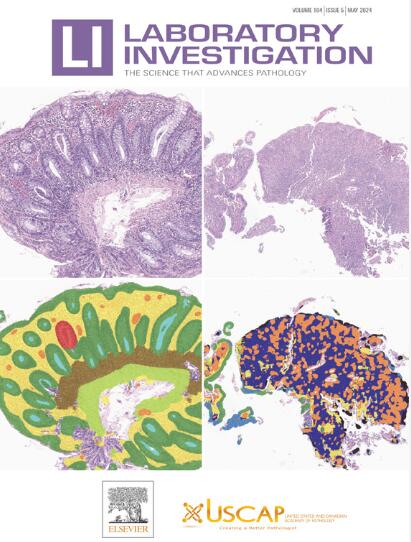基于计算机的结直肠锯齿状病变检测:数字平坦度,一种设计用于整片图像的新度量
IF 4.2
2区 医学
Q1 MEDICINE, RESEARCH & EXPERIMENTAL
引用次数: 0
摘要
结直肠无柄锯齿状病变(SSLs)和增生性息肉(HPs)的特征是锯齿状或星状上皮结构。区分SSLs和hp至关重要,因为在30%的病例中SSLs是结直肠癌的前体,而hp可能是SSLs的前体。SSL与HP的区别主要基于体系结构特性。事实上,SSL的标志是典型的隐窝设计和轮廓的明显扭曲,显示出沿粘膜肌层的水平扩张和隐窝基部的扩大,特别是在隐窝的下三分之一。分析数字化组织图像的能力导致了创新的自动化组织分析,从而提高了病理学家报告的可重复性和客观性。最近有一些研究探索了通过自动定量分析来诊断和分级结直肠癌,但都没有关注SSL检测。本研究旨在通过定义特定的度量来描述SSL最常见的视觉特征,从而开发一种自动化的SSL诊断方法。我们开发了一个处理流程,包括自动分割所有组织结构,用于计算定量形态学和结构特征,从而可以检测ssl。特别是,我们设计了一种新的度量,数字平面度,它在数值上表征了腺体轮廓边缘与肌层粘膜轮廓的平行度。在759个息肉腺体的数据集中,我们的新检测方法的特异性为92%,灵敏度为83%,准确率为92%。我们的结果代表了一个简单,常见,但仍在胃肠道病理学家争论的问题的第一个方法,从而为客观和标准化的SSLs个性化提供了有效的支持。本文章由计算机程序翻译,如有差异,请以英文原文为准。
Computer-Based Detection of Colorectal Serrated Lesions: Digital Flatness, a Novel Metric Designed for Whole-Slide Images
Colorectal sessile serrated lesions (SSLs) and hyperplastic polyps (HPs) are characterized by sawtooth or stellate epithelial architecture. Distinguishing between SSLs and HPs is crucial as SSLs are precursors of colorectal carcinomas in 30% of cases, whereas HPs are likely precursors to SSLs. The differentiation of SSL from HP is primarily based on architectural features. Indeed, the hallmark of SSL is a substantial distortion of the typical crypt design and silhouette, which shows horizontal expansion along the muscularis mucosae and enlargement of the crypt base, especially in the lower third of the crypt. The ability to analyze digitized histologic images has led to innovative automated tissue analysis, thereby improving reproducibility and objectivity in pathologists' reports. Some recent studies explored colorectal cancer diagnosis and grading through automated quantitative analysis, but none of them focused on SSL detection. This study aimed to develop an automated method for SSL diagnosis by defining specific metrics to characterize their most common visual features. We developed a processing pipeline involving the automatic segmentation of all the tissue structures required for computing quantitative morphologic and architectural features, which allows detection of SSLs. In particular, we designed a novel metric, digital flatness, which numerically characterizes the parallelism of the gland's contour edges with the muscolaris mucosa profile. In a data set of 759 polyp glands, 41 of which were reported as SSLs by expert pathologists, our novel detection method achieved specificity of 92% and sensitivity of 83%, with accuracy of 92%. Our results represent a first approach to a simple, common, but still debated issue among gastrointestinal pathologists, thus providing valid support for the objective and standardized individuation of SSLs.
求助全文
通过发布文献求助,成功后即可免费获取论文全文。
去求助
来源期刊

Laboratory Investigation
医学-病理学
CiteScore
8.30
自引率
0.00%
发文量
125
审稿时长
2 months
期刊介绍:
Laboratory Investigation is an international journal owned by the United States and Canadian Academy of Pathology. Laboratory Investigation offers prompt publication of high-quality original research in all biomedical disciplines relating to the understanding of human disease and the application of new methods to the diagnosis of disease. Both human and experimental studies are welcome.
 求助内容:
求助内容: 应助结果提醒方式:
应助结果提醒方式:


